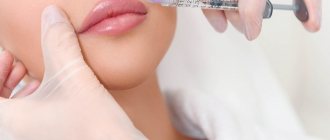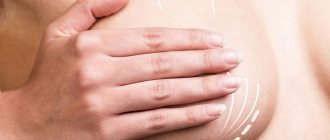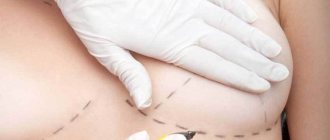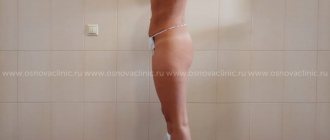The duration of incision healing and the postoperative appearance of the scar depend on the type of surgical approach, the technique of breast surgery, the method of application and the number of sutures, and the individual characteristics of the patient’s skin.
Scars after mammoplasty can be located under the breast (submammary access), on the border of the dark skin of the areola (periareolar access), in the armpit (transaxillary access), in the navel area (transabdominal access, used for simultaneous mammoplasty and abdominoplasty).
Modern medical technologies in the field of plastic surgery and a variety of access options make it possible to “hide” the incision sites as much as possible and make postoperative scars invisible. However, under unfavorable circumstances, after breast surgery, rough scars that rise above the surface of the skin may remain, which bring psychological and physical discomfort to the patient.
| Removal of scars after breast surgery | |
| Laser removal of stitches after linear breast lift (session) | RUB 9,350 |
| Laser removal of stitches after anchored breast lift (session) | RUB 11,550 |
| Surgical excision of sutures after linear breast lift | 65,000 rub. |
| Surgical excision of sutures after anchored breast lift | RUB 86,000 |
Sign up for a consultation
Scar care and linen after mammoplasty
Most often, the day after mammoplasty, the woman is at home. On the first day, there may be a painful sensation of skin tension due to postoperative swelling. If there is swelling, you should not take a bath for three weeks. Usually, with medication, the swelling and pain disappear within a couple of days. If bruising occurs, gels containing heparin or troxevasin should be used.
After removal of sutures and local peeling, a gel such as Contractubex can be used to smooth and soften the scar (up to 3 times a day). At night, it is more convenient to apply a silicone plate to the postoperative scar , designed to accelerate the maturation of the scar. From this point on, it is necessary to gently massage the scar several times a day to prevent the formation of fibrous-capsular structures. Massage can be combined with rubbing a moisturizing lotion or cream into the skin , which will restore softness and elasticity to the skin and prevent it from losing tone and elasticity.
Regardless of the purpose of the operation (lifting or reducing the mammary glands), the placement of implants always involves the removal of part of the skin and a fixation suture of the mammary gland in a certain position in relation to the chest. To prevent these seals from increasing in size, the use of special plasters (strips) in the form of strips is required to secure the edges of the seam. Typically strips are used for up to two or three months.
Compression garments , elastic shirts and bras are used in conjunction with the patch Such clothing will reduce the load on the operated breast and will not allow it to sag and lose shape. In addition to compression, the garment improves scar healing and maturation.
Silicone patch
Clinical studies have shown that silicone has a positive effect on the healing of scars (postoperative, hypertrophic, keloid, scars after cuts, burns and injuries). Silicone patches are also used to prevent scar growth.
Method of application : the patch is glued to the scar and is not removed during the entire course of therapy.
Advantages:
- perfect fixation;
- not noticeable under clothes;
- breathable;
- does not get wet;
- suitable for daily wear;
- can be reused (when removed, the patch does not lose its properties);
- one patch can be used for 7 days or more.
Recovery after breast reduction
During the rehabilitation period, if mammoplasty was performed for the purpose of breast reduction, you should take at least one week off from work or school. Some patients may need two weeks, but each situation varies. Your surgeon will make an appointment for you to remove the bandage and sutures 7-10 days after surgery.
During the recovery period, you must stop physical activity for at least one month after surgery.
After breast reduction surgery, you may feel tired and have breast pain. This is fine. To reduce these symptoms, you may be prescribed painkillers for the first few days after surgery. You should also avoid heavy lifting.
How to treat a rough (keloid) scar?
Treatment for rough scars can be either simple medication or surgery. The most effective way is to use these methods together. In fact, the formation of rough scars, and even more so a keloid, is an out-of-control formation of the connective tissue that makes up the scar. The processes of connective tissue synthesis prevail over the processes of its maturation and transformation into mature connective tissue. The goal of the treatment is to first try to prevent the disruption of the normal formation of connective tissue into uncontrolled synthesis, and then to prevent rough synthesis of connective tissue throughout the entire period of scar formation.
The essence of surgical treatment and its principles are as follows:
- Excision of a rough scar with plastic surgery of the skin wound using local tissue. There are different types of plastic surgery. In each specific case, the surgeon chooses the appropriate technique.
- Remove excess tension on the edges of the wound. To do this, the surgeon widely mobilizes the edges of the wound. Internal sutures are placed deep inside. In this case, even minimal tension should not apply to the edges of the wounds.
- Care for soft tissues during surgery. It is necessary to exclude the use of electrocoagulation. You need to take the skin with tools very carefully, avoiding even minimal crushing.
- Suture material for suturing a skin wound should be based on polypropylene, a biologically inert material. The thread should be monofilament and as thin as possible. It is not allowed to use braided threads that have a sawing effect when sewing leather. Threads such as Lavsan, Etibond, silk and the like should not be used on the skin, as they cause an increased skin reaction.
Drug treatment can be used either alone or in addition to surgical treatment. The essence of this treatment comes down to the following principles:
- The use of skin-fixing patches that relieve excess tension during the entire period of scar formation.
- The use in the postoperative period of various ointments and patches with medications that slow down the excessive formation of connective tissue.
- Injections of steroid glucocorticoid drugs to block excessive formation of connective tissue. The injection is made directly into the hypertrophied scar, which makes it possible to stop the process of keloid formation with a high degree of probability.
conclusions
| First of all, we must remember that the prevention of severe scarring and the formation of keloid scars should begin immediately after the incision is made. This is the key to good healing and an invisible scar in the future. For statistics, it must be said that rough (keloid) scars with breast augmentation are extremely rare. The frequency is significantly less than one percent, since the incision is located in places favorable for healing. |
It is important for patients to pay attention to how their scars look until six months after surgery. Take the time to get information from your doctor about what to pay attention to during this time. And, of course, any patient will not have unnecessary questions if she is not too lazy to come for periodic examinations after surgery.
Complications and side effects after breast reduction surgery
A normal side effect of breast reduction surgery is scarring. These scars will diminish and smooth out over time, but never completely disappear. However, the location in the folds of the skin makes the scars invisible from the outside. Scars may be worsened by heavy lifting shortly after surgery. In rare cases, some patients experience certain complications, such as poor healing of the wound in the nipple area, which may require additional surgery to place a skin flap in the area.
After breast reduction surgery, you should immediately consult a doctor in the following cases:
- At the first signs of infection, including a significant rise in temperature;
- If you have any unusual discharge from the incision site (including pus);
- If any of the sutures come apart before the time of removal.
If you consult a doctor in time, he will be able to eliminate complications and avoid unpleasant consequences for the aesthetic results of the operation and your health.
Cost of mammoplasty surgery
Types of Scars
- normotrophic - this type of scar remains after a successful operation, such scars are barely noticeable, have a light color that “merges” with the natural skin tone, and stretch well; easy to correct using cosmetic procedures;
- hypertrophic - this type of scars is most often temporary and becomes less noticeable within a few months after plastic surgery; the scars rise slightly above the surface of the skin and have an unnatural pink color; depending on the size and structure, the scar can be removed either by one of the cosmetic methods or by surgery;
- keloids - appear during a complex healing process, rise above the surface of the skin, have a dense, uneven structure, irregular shape, can reach significant sizes and cause pain when touched; characterized by rapid aggressive growth, which is accompanied by the germination of surrounding healthy tissues; can be eliminated by cosmetic and surgical techniques, including their combination.
If the patient knows that his skin is prone to the formation of keloid scars, then the doctor must be informed about this in advance, even before breast surgery. The body of most patients is not prone to the formation of rough scars. However, if there is a hereditary predisposition, the risk of keloid scar formation increases. In addition, sutures after breast surgery can turn into keloids due to excessive skin tension, which is formed, for example, as a result of the introduction of implants, incorrect suturing, as well as due to improper postoperative care, non-compliance with doctor’s recommendations and the peculiarities of the patient’s immune system. .
What to do if a simple lift is not enough?
- If any doctor tells you that this type of operation does not leave any traces, do not believe such a specialist. However, with proper care and following all recommendations, in just six months the scars will become almost invisible, and after a year they will become completely invisible. Of course, the professionalism of the plastic surgeon also plays an important role in this matter - it is important that during the operation he takes care of the aesthetic consequences in advance. In order to end up with the thinnest, unnoticeable seam, I use special technology and give patients special recommendations for caring for it at home. They are not difficult to perform, but the more competently you follow my advice, the more beautiful and aesthetically pleasing the scar will be in the end. If you are ready to undergo several post-operative procedures with the clinic’s professional cosmetologists, then you will achieve an amazing result.
When deciding to undergo a full breast lift, a woman can be sure that she will end up with an ideal appearance and confidence in her beauty. Now she will be able to wear elegant evening dresses with a cutout, any swimsuits and lingerie. The most important restriction after the intervention is a ban on tanning for a year, but I think it is not very burdensome. And in the erotic twilight of the bedroom, the seam will definitely not be noticeable!
You can get all the necessary information and sign up for a consultation: HERE
Breast augmentation: scars, their types, location
N ormotrophic scar. Does not protrude above the surface of the skin, is hardly noticeable, lighter than the epidermis.
Hypertrophic. Protrudes above the skin, has a pink or unnatural white tint. It is the result of excess formation of connective tissue. Formed after inflammation and long regeneration.
Keloid . It extends beyond the wound, hangs over the skin, and has a bluish or purple color.
You can work with each type of scarring: there are methods for their aestheticization. It is important to start treatment on time, preferably 2-3 weeks after mammoplasty.
Where will the seams remain?
When accessed under the mammary glands, they will be covered by a fold of skin.
With periareolar, there is a protruding colored part of the areola.
Axillary – lowered arm.
Characteristics and types of scars
Postoperative scars are of the following types:
- normotrophic,
- atrophic,
- hypertrophic,
- keloids.
Normotrophic scars are almost invisible, and are at the same level as the skin. But their color tone is much paler than the rest of normal skin.
Typically, scars after breast lift and augmentation are normotrophic; they do not protrude and do not form strong compactions.
Atrophic scars are possible due to the characteristics of the patient's skin. They are formed from an acute lack of collagen in the inner layers of the skin. Such scars look decrepit and unnatural, so their treatment should be considered first.
Hypertrophic scars are considered a postoperative complication of breast surgery; they usually have a bright pink tint and an uneven, protruding surface above the skin level. Similar consequences of plastic surgery and braces also need to be intensively combated.
And the last, keloid scars, are called by surgeons the clearest and most noticeable of all the others. Unfortunately, they are also difficult to cure, and only a competent and highly qualified approach can ensure the elimination of such defects.
It turns out that it is necessary to try to perform mastopexy using this method in any case?
- A very common opinion. By the way, it was erroneous, and some had to pay quite dearly for their error. Almost all girls urgently ask for surgery through the areola, but the main nuance is that this option has many restrictions on its use. For example, if the stage of ptosis is high, it will simply not be possible to remove excess tissue evenly. If you cut off the top part of the cone, you can imagine the shape of the breast - it will become ugly and flat, and unattractive ridges of skin will appear near the nipple.
If the girl still insists on the method described above, I am forced to refuse such patients the operation. Reasonable women usually agree with my recommendations, but persistent ones find another specialist who agrees to perform periareolar intervention. What happens as a result? They come to me again, this time with a request to correct this “terrible appearance.” To prevent this from happening to you, remember: if an experienced surgeon talks about the need to make an incision, it is not because of a desire to make the operation longer and more complex. And the goal here is not to make as many different cuts as possible. Taking into account the experience and results of previous interventions, the doctor will select the best method and offer you the right solution.









